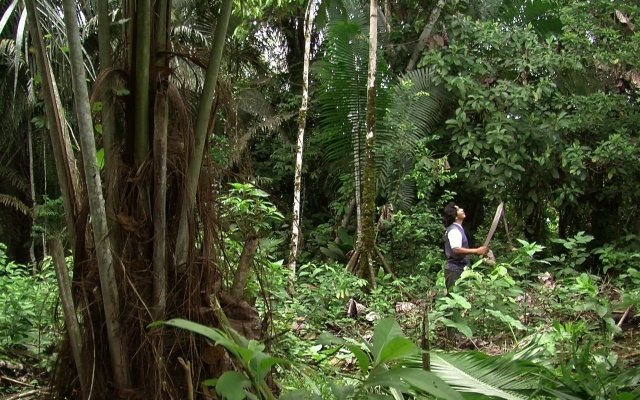Fisrt published in Elements for a World: Wood, ed. Ashkan Sepahvand, Sursock Museum, Beirut 2016, pp. 18-23. Reprinted here courtesy of the Author.
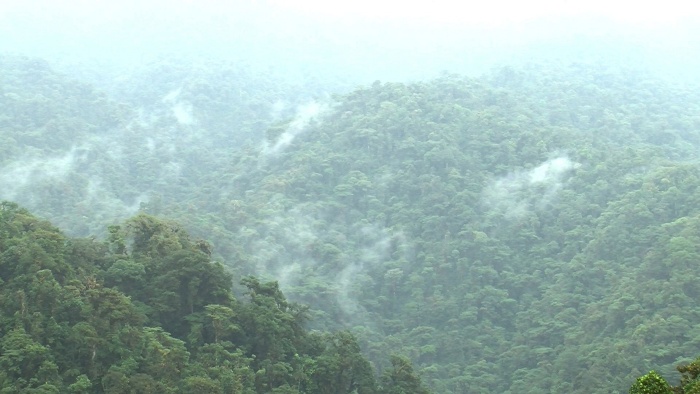
Klatka z filmu "Forest Law" (2014) autorstwa Ursuli Biemann i Paula Tavaresa. Dzięki uprzejmości autorów.
THE CASE OF THE KICHWA INDIGENOUS PEOPLE OF SARAYAKU V. ECUADOR.
PUBLIC HEARING
INTERAMERICAN COURT OF HUMAN RIGHTS
COSTA RICA, JULY 8, 2011
WITNESS
SABINO GALINGUA
President of the Court: I give the floor to the representative of the alleged victims, Mario Melo.
Representative: Good afternoon, your Honors. Good afternoon, Don Sabino. I would like you to please explain to the court your role in the community.
Witness: I am one who, from early childhood, knows all about the forest. I know the forest, I know the rivers, I know life, including that of stones.
Representative: Don Sabino, why is this territory important for the people of Sarayaku?
Witness: Sarayaku is living land. It is a living forest where trees and medicinal plants and all kinds of beings live.
Representative: When the workers of the oil and gas company CGC entered the forest, they destroyed a well-known, sacred Lispungo tree, which had an effect on one of the ancient sages, Mr. Cesar Vargas. Could you tell the court what happened at that time?
Witness: The land of Mr. Cesar Vargas is located in a place called Pingullu. That’s where he lived with his trees. When they took this big Lispungo tree with the fibers he used for healing, he was deeply saddened, and his wife died. Then he himself died. They had two sons who died also, one after the other. Now there are only two daughters left.
Representative: Don Sabino, could you explain to the court what the effects were of the actions taken by the company CGC in the territory of Sarayaku in relation to the beings who inhabit the territory and whom the common people cannot see?
Witness: There are beings living in the forest that my ancestors and my parents encountered and saw; this was very common. The masters of the forest live there. We are not the owners of the forest. The Amasanga, one of the masters of the forest, lives there; the Sacha Runa live there. My ancestors could see them. If they disappear, it would be a calamity.
Representative: What happened to these beings when CGC began to place explosives in the forest?
Witness: If the explosives are detonated, all these beings will die, flee, or disappear, generating great illness.
Representative: Don Sabino, what do you think was the effect of the oil company’s presence in Sarayaku on the daily life of the people?
Witness: It was a disaster because many of our people were sent to protect the territory. We lost our work and our crops. We couldn’t attend to our work because we had to defend the territory. We are hunters. Every three months we go hunting. Now people cannot access this space because of the explosives. This sector was also the habitat of the masters of the forest, who preserve the ecosystem.
Representative: When you refer to the masters who preserve the ecosystem, are you referring to persons, to spiritual beings? Could you explain a bit more to the court?
Witness: Many are hiding, others have died. They are the ones who sustain the rainforest. When too much life and too many things are destroyed, the mountains, too, break apart. We are living in the Bombonasa basin; this definitely affects us. Outsiders who do damage here don’t know what they are doing. We do know because we can see it.
In the mid-1990s, in the context of savage neoliberal adjustments and austerity, the Ecuadorian State sought to increase revenues by expanding corporate oil extraction over vast regions of its Amazonian lands, unleashing a process of massive enclosures over indigenous territories. As part of this global bid, the Argentinian company CGC acquired the right to explore a giant concession known as “Block 23,” 65% of which overlapped with the legally recognized territory of the Kichwa people of Sarayaku. First came geologists and anthropologists offering low-ranking jobs in the oil industry and “development projects,” but as communities refused to bargain their lands, then came military troops, arbitrary imprisonments, and legal persecutions. Curtailing of human and civil rights, the privatization of the commons, and environmental depletion arrived in hand in hand.
Confronting another violent wave of colonization, the Sarayaku people responded with a peaceful strategy of resistance that combined actions on the ground, through the mobilization of “peace and life” encampments to protect the forest, with actions in the courts of law, through a case filed against the Ecuadorian State in the Inter-American Court of Human Rights. This appeal attempted to counteract decades of abuse of indigenous land and human rights by the state and the global oil industry, which in the previous decades had led to widespread contamination and an ensuing humanitarian catastrophe in the north of the Ecuadorian Amazonia.
The technique employed to prospect and map oil reserves consists of carving out a geometric grid composed of 100 meter-wide squared cells over the entire concession territory, and then gradually detonating tons of explosives deep underground at each of the grid nodes to provoke powerful seismic disturbances. Together with the paths of deforestation conducted to trace the grid on the ground, these geological bursts, which amount to tens of thousands of explosions across the territorial mesh for about two years, caused the massive displacement of wildlife and death of fish. For the state and its corporate cohorts, this was modern development being brought to Amazonia; for the Sarayaku people, this was perceived as a form of colonial violence that affected not only their communities, but also the forest and the multiplicity of nonhuman beings housed by the forest, elements and entities that play a fundamental role in their cosmology and modes of life.
In his testimony before the court, Sabino Gualinga, a shaman in his late age, tried to convey to the judges the effects of this form of violence against nature, describing a singular relationship with the land embodied in what his people call kawsak sacha, “the living forest.”
In the Bobonaza River Basin, where the ancestors of the Sarayaku Kichwa made their home, forests are not what they usually appear to us: empty natural environments, whether in the form of biological reserves or pools of raw materials to be commoditized. Mountains, trees, marshes, and rivers, Don Sabino explains, are llaktas, “villages” or “towns,” forming a complex cosmological architecture that houses all sorts of beings, both human and nonhuman, who are deeply entangled, mutually constitutive, and interdependent. Kawsak sacha is the territory of the Amasanga and the Sacha Runa, the refuge of jaguars and tapirs, and also the source of water, food, and medicine for local communities – the ecological and symbolic material upon which the Sarayaku people forge their subsistence, culture, and history.
In the strategy of the prosecution, it was fundamental to assert to the court the singular way the Sarayaku people understand and relate to the forest. This allowed for the argument to portray the conflict not only as a dispute over control of resources and land rights, but foremost as a clash between two incommensurable, dissident perspectives over nature: one that sees the forest as a raw commodity open for capitalist exploits; the other which dwells in the forest as a living entity. The lawyer Mario Melo, the main representative of the plaintiffs, explains that Sabino Gualinga’s testimony was important in that respect because he could communicate how the impacts of oil extraction activities caused an “injury that goes beyond human interests.” Since the forms of violence that produce such injury are not immediately directed at human bodies but to the environment, as in the case of seismic explosions and deforestation, they tend not to be perceived as violence at all. From the point of view of indigenous communities, however, the advancement of the oil frontier configured a vector of destruction, inasmuch as their modes of life and inhabitation were coextensive with the life of the forest and its beings. José Galingua, one of the leaders of the Sarayaku council, explains this in the following words:
“The explosives are buried in a forest area that is meant for the reproduction and repopulation of animal species. We have organized the forest by means of maps into hunting zones, fishing zones and reserves, which we consider the living forest, and that is where they have buried the explosives. It’s an area we hardly ever visit because these are sacred places.
According to the international classification, an explosive is dangerous when it is attached to the body – that is classification A. Classification B is when an explosive is left in a building, for example, in that case you can evacuate people. And classification C is when you suspect explosives somewhere far away. The state tried to minimize the presence of the explosives on Sarayaku territory by saying it falls into category C, because they are far from the Sarayaku people and they don’t present a threat. Hence there is no need to remove them.
But for us their presence represents category A, and that is what we told the state: that the explosives are attached to the human body, to the body of the Sarayaku people, because our territory is our home. For strangers, these territories have no life, but for our people, who live here, these territories are alive. I would like people to imagine explosives in Carondelet, the presidential palace, or in the White House. How would the citizens react if there were thousands and thousands of pounds of explosives underneath those buildings?
It was important to make the court understand how enmeshed the people of Sarayaku are with the mountains, the lagoons, the trees; with the Amasanga, the Sacha Runa, the Yashingu; and with all the natural spaces that include invisible beings, the protectors regulating the ecosystem. These beings have more fundamental rights than any of us because they are the ones who protect. We wanted the court to understand the importance of the territory of Sarayaku, and to understand that if the territory disappears, the indigenous people disappear with it.”
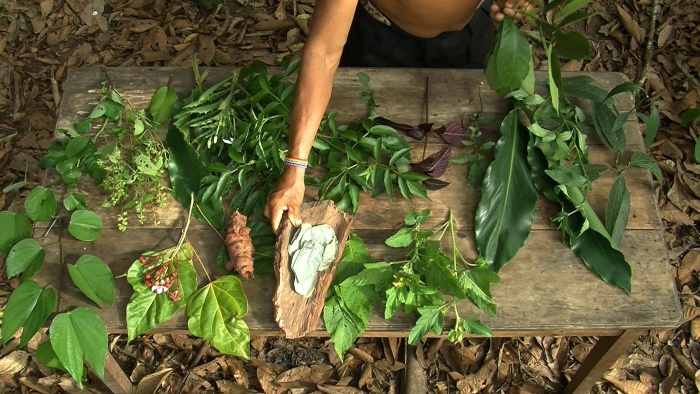
Klatka z filmu "Forest Law" (2014) autorstwa Ursuli Biemann i Paula Tavaresa. Dzięki uprzejmości autorów.
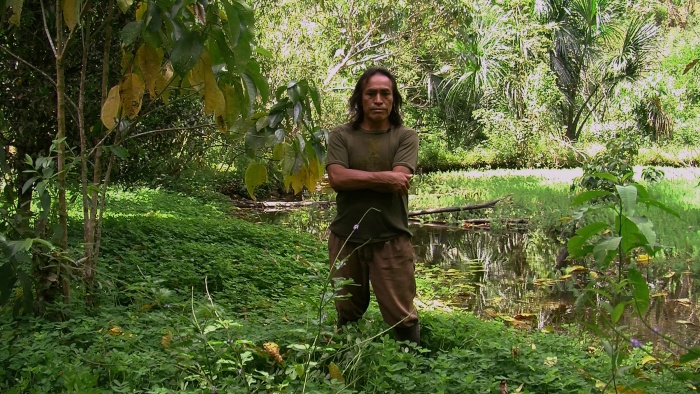
Klatka z filmu "Forest Law" (2014) autorstwa Ursuli Biemann i Paula Tavaresa. Dzięki uprzejmości autorów.
As expressed by the images of earth-body attachments and the architectural metaphors employed by José Gualinga, the Sarayaku people see the forest as an environment saturated with humanity and inherently as a cultural space. Inside the forums of modern law – a space within which, being structured upon Western cosmology, nature only enters represented as an external object of human appropriation – the concept of kawsak sacha raised all sorts of controversies and mistranslations. It required the court to interpret the forest as something more than an object and property, displacing the centrality of the human and positioning nature as a “subject” of violence and injury. To explain this cosmo-political construction to the judges, the prosecution called the anthropologist Rodrigo Villagra Carreón as an expert witness:
President of the Court: Mr. Carreón, do you swear, or solemnly declare, that you exercise your function of expert in all honor and conscience?
Expert: Yes, I swear.
President: You may have a seat.
Expert: As an anthropologist, I would like to start by speaking about the interconnection that exists on various levels between the territory, the culture, and the cosmology of Sarayaku. That is to say, human activity, life, and cosmological ontology are intimately tied together. There is interdependence. Child-rearing; the education of children; the practice of shamanism; production in the forest; and the forest beings, the Sacha Runa, are extremely intertwined with life, with human activities, and with the social organization. The Yachaks, the shamans, constitute an indispensable and vital element in this connection with the living forest. What they do, in some way, is participate on multiple levels in relating the living forest to the humans.
There are many beings in the living forest. From the metaphysical materialist position, this probably doesn’t make much sense, but it is consistent in the epistemology of indigenous people. (...) We speak of the cosmos as an interrelated multiplicity – el kawsak sacha, the living forest. There are subterranean cities, beings who dwell inside the water, and these beings are in contact with the shamans.
Claude Lévi-Strauss said that the difference in our evolutionary theories is that, for us, in the beginning, humans and animals were all animals; in the Amerindian philosophy and cosmology, animals and humans were all human – i.e., human in the sense that they had intentionality, the ability of deliberate intervention, which we keep apart in our own epistemology. When some of these beings disappear, or maintain a negative relationship with specific persons or a specific society, all the animals disappear also.
When we speak of multiple cosmos, we speak of a reverberation of worlds that resemble each other, that have Yachaks (healers), villages, people. For instance, the world of the Sacha Runa, the subterranean world, and the aquatic world are similar to ours. Thus, these places not only signify materially what for us is an ensemble of plants or a characteristic geography, but they additionally have an implication that we would call spiritual. They are populated. The forest is a populated territory, it is a dynamic territory – far from a homogenous terrain – where a great deal of diversity occurs. All this diversity doesn’t go unnoticed or is hidden from the eyes of the people who live there. In this sense, the territory, knowledge, possibilities, and productive potential, as well as human reproduction, are intimately related.
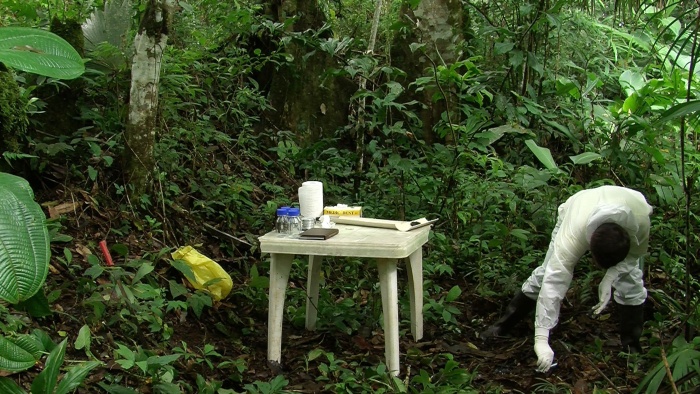
Klatka z filmu "Forest Law" (2014) autorstwa Ursuli Biemann i Paula Tavaersa. Dzięki uprzejmości autorów.
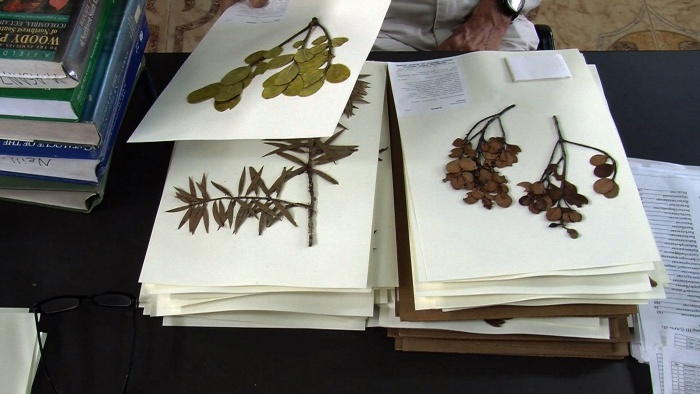
Klatka z filmu "Forest Law" (2014) autorstwa Ursuli Biemann i Paula Tavaresa. Dzięki uprzejmości autorów.
Carreón’s testimony describes a characteristic common to many indigenous cultures across the Americas, namely the conception that the world is inhabited by various types of persons and societies, both human and nonhuman.1 This animist principle is grounded on the establishment of a certain shared status of personhood between peoples and nature, which is most clearly manifested in the idea that nonhuman beings codify reality in a manner akin to cultural forms, as implied in the term llaktas – villages/towns – used by the Sarayaku people to refer to spaces of the forest. The anthropologist Eduardo Viveiros de Castro explains this aspect of Amerindian thought by drawing on similar architectural images:
“Animals and spirits see themselves as humans: they perceive themselves as anthropomorphic beings when they are in their own houses or villages and they experience their own habitats and characteristics in the form of culture ... Being people in their own sphere, nonhumans see things as ‘people’ do. But the things that they see are different: what to us is blood, is maize beer to the jaguar; what we see as a muddy waterhole, the tapirs see as a great ceremonial house.”2
If modern sciences are based on an incremental process of the objectification of reality, Amerindian sciences are based on the art of “perspectivism,” a mode of perceiving and engaging with the world as a multiplicity of worlds instead of a single object-unity. In contrast to Western cosmology, where the social is restricted to the domain of the human species, in Amerindian thought the space between humans and nonhumans, peoples and nature, is from the outset a socialized space. “What we call the environment is for them a society of societies, an international arena, a cosmopoliteia... the platitude that every novice left-wing militant learns – that everything is political – acquires in the Amerindian case a radical concreteness.”3 Such conception of the forest as a cosmopoliteia implies that every being that inhabits in the forest – trees, jaguars, peoples – are some sort of city dwellers, that is, they are “citizens” within an expanded polity formed by complex material and symbolic ties between society and nature. The nature of nature is social, and hence the ways we imagine, relate to, and represent nature – whether in the forums of art or law – are fundamentally political. The forest is a polis: a political arena where both the concepts of human and rights are being defined anew.
The Rights of Nature introduced in the Ecuadorian Constitution of 2008 stem from struggles such as the Sarayaku legal battle, which formed part of a constellation of indigenous mobilizations against the neoliberal enclosures of the 1990s. Kichwa Indigenous People of Sarayaku v. Ecuador became a landmark case in nonhuman rights jurisprudence. At the same time, the trial casts the shadow of centuries of colonialism and speaks of a broader global conflict. For it also refers to the context of anthropogenic climate change, rampant biodiversity extinction, and widespread toxic pollution. Deeply rooted in situated histories of colonial violence, the forest court calls for the constitution of a universalist, multi-species politics beyond the human.
BIO
Paulo Tavares is an architect based in Brasília, where he is currently a professor at the Faculdade de Arquitetura e Urbanismo, University of Brasília. He has published and lectured widely in different contexts and locations, including ETH Zurich, Haus der Kulturen der Welt, the Ireland Biennale, the Mercosul Biennale, and the São Paulo Biennale. In 2015, he was a Visiting Scholar at the School of Architecture at both Princeton and Cornell Universities. Prior to that, Dr. Tavares taught Design Studio and Spatial Theory at the School of Architecture, Design, and Arts of the Pontificia Universidad Católica del Ecuador in Quito, and at the Centre for Research Architecture, Goldsmiths, where he also completed his Ph.D. His work has been exhibited in various venues worldwide, including BAK, Utrecht; Fundación PROA, Buenos Aires; Haus der Kulturen der Welt, Berlin; the Taipei Biennale; and ZKM, Karlsruhe. He is the founder of the agency autonoma, a platform dedicated to urban research and intervention.
* Cover photo: a still from the video "Forest Law" (2014) by Ursula Biemann and Paulo Tavares. Courtesy of the Authors.
[1] Eduardo Viveiros de Castro, Cosmological Deixis and Amerindian Perspectivism, in The Journal of the Royal Anthropological Institute, Vol. 4, No. 3, (Sep. 1998), pp. 469–488, pg. 469.
[2] Eduardo Viveiros de Castro, Cosmological Deixis and Amerindian Perspectivism.
[3] Déborah Danowski and Eduardo Viveiros de Castro, Há mundos por vir? Ensaio sobre os meios e os fins, Cultura e Barbárie, 2014, pg. 94.



